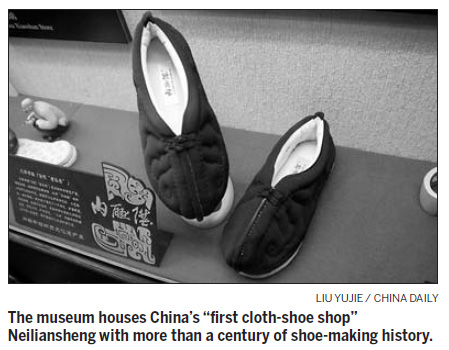Sole searching, or shopping in history
As the inexorable progress of modern commerce and glass and steel edifices bury the old facades of Beijing, it becomes harder to seek out the essence of Old Beijing.
The shoe museum at Neiliansheng's shop, which cradles a traditional brand with more than one hundred years of shoe-making history, will take you back in time.
 |
Neiliansheng, "the first cloth-shoe shop in China" as tagged by the China General Chamber of Commerce, boasts of being masters of the craft of "multi-layered sole", listed by authoritative archaeology magazine American Archaeology as one of the "Top 10 Archaeological Discoveries of 2008". In the same year, the craft was listed on China's second intangible cultural heritage list.
American anthropologist Eric Kostlin thought the human phalange found in the vicinity of the Zhoukoudian Peking Man site indicated that people were already wearing shoes almost 40,000 years before the cow-leather sandal dating from 3000 BC found in ancient Egypt.
Against such a historical pedigree, Neiliansheng's flagship store felt it was necessary to create a small museum on the third floor of its building on the prosperous Qianmen Dashilar Commercial Street, south of Tian'anmen Square. It aims to document the long history of shoemaking in China, and to let more people know about China's traditional cultural treasure.
He Kaiying, the fourth-generation master of Neiliansheng, says, "The craft of multi-layered sole shoes has a long history and is a remarkable achievement in shoe-making history. It condenses the essence of unique crafts of our nation, reflecting the people's industrious traits. It carries tremendous historical, cultural and craftsmanship values."
In China, the first documentation of shoes in art appeared on ancient pottery of the clan-society period. The earliest surviving shoes are a pair of leather hand-sewn shoes unearthed from a Chu Tomb in Changsha, Hunan province. It was made from braided grass, cane and arrowroot. Ordinary people tended to wear cloth shoes while nomads and soldiers wore leather.
An excavated picture of a kneeling knight in the Zhou Dynasty shows us the earliest multi-layered sole shoes in history. Another image suggests the multi-layered sole shoes of the Qin Dynasty (during the Warring States Period, 475-221 BC) were well-preserved in the terracotta warriors and horses of Qin Shihuang's Mausoleum.
Cloth shoes with outsoles originated from the Zhou Dynasty, and making these soles was once one of the daily chores of women, a craft passed down through thousands of years from generation to generation.
In the late Qing Dynasty (1644-1911), with the beginning of modern commerce, a variety of specialty workshops like Neiliansheng started up, all making the multi-layered sole shoes. For more than a century, Neiliansheng has taken the original craft and brought it to new heights.
A flow chart of the manufacturing process is on the wall of its museum, with a row of different ropes and cloths in the inner showroom explaining in detail how a pair of cloth shoes is made at Neiliansheng.
The procedures are so complex and the craft so exquisite that it takes more than 90 steps to make pair of shoes. Each step conforms to specifics, strict and unsparing requirements. Its production stresses size, technique, strength and care and the shoes must be clean, supple and precise.
Multi-layered soles are first immersed in hot water and then subjected to hot steam for hours before they are beaten over and over on a stone to become flat and sturdy.
More than 40 tools are used in the whole process and it takes four to five days to finish a pair of shoes.
At the museum, the history of Neiliansheng is illustrated in animation and tells the story of the founder, Zhao Ting from Wuqing Town in Tianjin. He learned shoe-making and accumulated a set of business and service tactics. Later, General Ding, a high-ranking official in the Forbidden City invested thousands of taels of silver to be a shareholder, providing financial aid for Zhao to set up the shoe store.
After doing a business analysis of the industry in the capital, Zhao found there were very few stores dedicated to making court boots and decided to fill that gap, making court boots for officials and relatives of the emperor. Targeting those "who sit in sedans" was the way Neiliansheng positioned its marketing.
These days, the shoe shop caters for all who want or need a pair of cloth shoes made to order at its chain stores. Among its loyal customers were top leaders such as Mao Zedong, Zhou Enlai and Deng Xiaoping, and entertainment celebrities like Jackie Chan, Ru Fulan and Tamasuburo Bando.
China Daily
(China Daily 02/20/2011 page15)






















